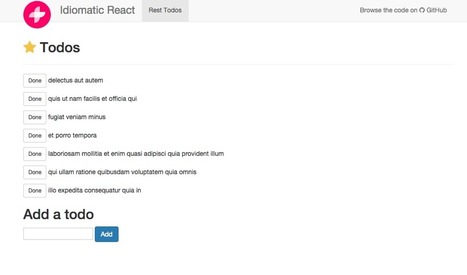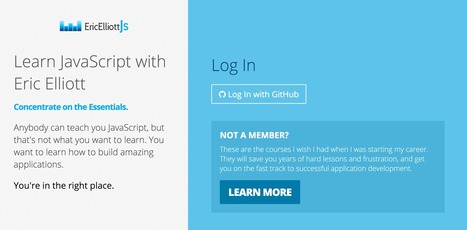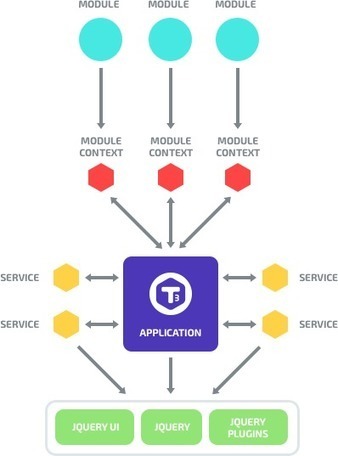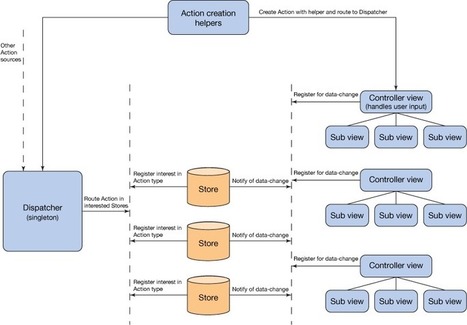This year Santa’s helpers have been tasked with making a garland. It’s a pretty simple task: string beads onto yarn in a specific order. When the garland reaches a specific length, add it to the main workshop garland. Each elf has a specific sequence they’re supposed to chain, which is given to them via a work order. (This is starting to sound like one of those horrible calculus problems. I promise it isn’t. It’s worse; it’s about Git.)
Get Started for FREE
Sign up with Facebook Sign up with X
I don't have a Facebook or a X account



 Your new post is loading... Your new post is loading...
 Your new post is loading... Your new post is loading...
Current selected tag: 'GitHub'. Clear
No comment yet.
Sign up to comment
From
github
Tiny Angular version 1 app written in Typescript with modularized Gulp tasks. Perfect as boilerplate.
From
github
It's complemented by Idiomatic React Chat (on the branch chat of this repository), implementing Facebook's Flux Chat app. Features
Considering the frequent mutation of technology happening on the React scene, we believe developers might feel the need for a simple, idiomatic app reflecting the current state of the technology and techniques, be it for bootstrapping awesome apps, or simply to improve their skills. This project aims to be simple and idiomatic. We're not there yet, and we rely heavily on contributors (on you !) to make this happen.
From
segment
Deku is our library for building user interfaces. It supports many of the features you’re familiar with in React but aims to be small and functional. You define your UI as a tree of components and whenever a state change occurs it re-renders the entire tree to patch the DOM using a highly optimized diffing algorithm. The whole library weighs in at less than 10kb and is easy to follow. It’s also using npm so some of those modules are probably being used elsewhere in your code anyway. It uses the same concept of components as React. However, we don’t support older browsers, so the codebase is small and component API is almost non-existent. It even supports JSX thanks to Babel.
Jan Hesse's insight:
From
github
Isomorphic means that it's designed to run a lot of the same code on both the client and the server. Typically that includes a lot of rendering and domain logic. (Not to be confused with isomorphisms from category theory / functional programming. That's a totally different thing.) There are many advantages to building apps this way, but the primary advantages are:
From
t3js
T3 is different than most JavaScript frameworks. It's meant to be a small piece of an overall architecture that allows you to build scalable client-side code. A T3 application is managed by theApplication object, whose primary job is to manage modules, services, and behaviors. It's the combination of these three types of objects that allow you to build a scalable JavaScript front-end. T3's design enforces best practices such as loose coupling by limiting how certain components can communicate with each other. Modules cannot interact directly with other modules but may communicate with them through an event bus. Modules may use services directly, but may only reference behaviors in a declarative way. These restrictions ensure that the various pieces remain loosely-coupled to make dependency management easy and maintenance self-contained. The loosely-coupled nature of T3 components means that creating tests is easy. Dependencies are injected into each component, making it trivial to substitute a mock object in place of real ones.
Jan Hesse's insight:
From
github
Paperclip is a reactive template engine that compiles HTML to DOM. All optimizations happen at compile time, so you can expect snappy and efficient user interfaces across desktop, and mobile devices. This essay explains how Git works. It assumes you understand Git well enough to use it to version control your projects. The essay focuses on the graph structure that underpins Git and how the properties of this graph dictate Git’s behavior. This focus on fundamentals lets you build your mental model on the truth, rather than on hypotheses constructed from evidence gathered while experimenting with the API. This truer model gives you a better understanding of what Git has done, what it is doing, and what it will do.
From
github
"best perceived speed, the greatest code freedom, and the strongest search engine optimization" Brisket is a framework for building single page web apps using isomorphic JavaScript. A Brisket app is both a traditional web site AND a single page web application at the same time. Brisket provides the tools that you need to spend your time focusing on your application's logic rather than on "what environment is my code running in?". So, you’ve found a nice Open Source project that has added great value to your own work and you want to give back. Before we move on, let me stress that this isn’t anything personal. This article doesn’t criticise anyone particular, and the ranty tone is just for your reading entertainment. I do not want to discourage you from contributing at all, neither to our own work, nor to any other product. Open Source works also because of your enthusiasm.
From
reapp
Reapp is everything you need to build amazing apps with React: a collection of packages that work together, our UI kit, and a CLI that scaffolds your app and includes a server and build system.
Jan Hesse's insight:
From
github
turbo-react applies only the differences between two HTML pages when navigating with links rather than create a new document, which enables CSS transitions between pages without needing a server.
Techs
A short list of the frameworks/libraries involved in the project. React components and Flux architectureThe app (try to) follow the React/Flux architecture. So all the code is divided into: actions,dispatcher, stores and views. Maybe I didn't always follow the pattern so strictly, as you will see after with stores, but I did my best to be clear. |
From
github
TodoMVC implementation built on top of React with JSX-TypeScript Essence is a CSS framework that implements the guidelines from Google Material Design Specification using Facebook's react.js library. Use it to easily build super-fast and great looking web & mobile interfaces.
Jan Hesse's insight:
From
vorlonjs
An open source, extensible, platform-agnostic tool for remotely debugging and testing your JavaScript. Powered by node.js and socket.io.
From
auth0
However, once you start creating a bigger app, you realize that just using React isn’t enough. So you start looking at Flux, which is the architecture Facebook uses to create React apps. As we learned in a previous blog post, learning how to conduct authentication in a Single Page App can get super complex. We had to learn about tokens, JWTs and how to integrate them with SPAs. Learning how to do it with Flux is even harder! That’s why in this blogpost we’ll learn how to add authentication to a React Flux app.
Jan Hesse's insight:
From
github
Flux Comparison by Example
Jan Hesse's insight:
From
github
Mesh is a universal interface for communicating with data sources whether it's your API, mongodb, pubnub, webrtc, socket.io, redis, or local storage. Easily build sophisticated features such as offline-mode, realtime data, rollbacks, and more with little effort. Mesh is entirely customizable, and doesn't make assumptions about how a data source works. You can easily build your own API adapter that's interoperable with all the other mesh plugins. A client-server web framework built on Node.js that allows front-end developers to easily create a 100% SEO compliant, component MVC structured web application with an optimized first page load.
From
github
awesome-react - A collection of awesome React libraries, resources and shiny things. Go beyond the browser DOM with the React JavaScript library for maintainable web UIs Start using React, an open source JavaScript library for easily creating UI view components and composing them to form modern web UIs. Follow this tutorial's examples to learn prescribed best practices for crafting React components in a maintainable and reusable manner.
Jan Hesse's insight:
JavaScript is a disgusting language. But I love it! It’s riddled with awful parts, was put together in 10 days, and now we have to suffer for the next 20 years (it turns 20 in a few months). However, it’s also the duct tape of the internet, and it works just about anywhere that there is a browser. It’s also perhaps the most misunderstood language. At hackathons, I see tons of students trying to get started with JavaScript, as they are trying to write web apps or cross platform mobile ones, and they often get caught on simple things. For that reason, I’ve put together a JavaScript study guide. |






























